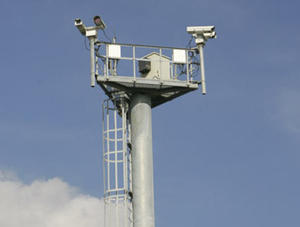GAO: Virtual border fence "unlikely to live up to expectations"
SBINet, to ambitious plan to build a fence with the most sophisticated technology along the U.S.-Mexico border, may not be the mother of all boondoggles, but it will surely compete for top honors in a competition for such a title; the Government Accountability Office has just issued a withering report about this troubled-from-the-start, never-up-to-speed project; GAO says that the designers of the virtual fence have lowered the fence’s technical standards “to the point that —-system performance will be deemed acceptable if it identifies less than 50 percent of items of interest that cross the border”; GAO also says that the project has been characterized by “decreasing scope, uncertain timing, unclear value proposition, and limited life cycle management discipline and rigor —-“

Virtual fence instrument tower // Source: wordpress.com
It was an ambitious plan: building a fence with the most sophisticated technology along the U.S.-Mexico border. Originally expected to run about 655 miles, the troubled-from-the-start, multibillion-dollar project has now been reduced to a plan for 387 miles, and its designers have lowered its technical standards “to the point that … system performance will be deemed acceptable if it identifies less than 50 percent of items of interest that cross the border.”
“The result,” said the Government Accountability Office in a withering report Thursday afternoon, “is a system that is unlikely to live up to expectations.”
DHS doesn’t even have “a reliable master schedule for delivering” even the “first block of SBInet,” as the Secure Border Initiative is known.
“As a result, it is unclear when the first block will be completed, and continued delays are likely,” the GAO said.
Jeff Stein writes in the Washington Post that, meanwhile, DHS does not have a realistic grasp of SBINet’s future costs, investigators found.
All in all, the report amounted to a grim picture of the project’s future, noting its “decreasing scope, uncertain timing, unclear value proposition, and limited life cycle management discipline and rigor ….”
It “remains unclear,” the GAO said, “whether the department’s pursuit of SBInet is a cost effective course of action, and if it is, that it will produce expected results on time and within budget.”
Indeed, DHS is rethinking the whole thing, SBINet’s executive director told Congress, according to the National Journal’s Nextgov.com Web site. “Is that the right technology in the right places, or are there better mixes and matches?” Mark Borkowski was quoted as telling a joint hearing of two House Homeland Security subcommittees on Thursday.
“Can we come up with something that’s a little more rational, that’s tailored to each area of the border?” Borkowski wondered out loud. “My expectation is that we would not end up with SBInet along the border. Already, that doesn’t look like a wise thing to do.”
Stein writes that the GAO’s findings on the long troubled project, launched with a $2.5 billion contract with Boeing Co. in September 2006, likely came as no surprise to the panel’s members. Some directed their irritation at DHS secretary Janet Napolitano, as they had at her predecessor.
DHS, however, insisted that the secretary “has already taken action to address the GAO’s recommendations.”
“The Department is redeploying $50 million of Recovery Act funding originally allocated for the SBInet Block 1 to other tested, commercially available security technology along the Southwest border, including mobile surveillance, thermal imaging devices, ultra-light detection, backscatter units, mobile radios, cameras and laptops for pursuit vehicles, and remote video surveillance system enhancements,” DHS spokesman Matt Chandler told Stein.
In the meantime, Chandler said, “DHS has frozen all SBInet funding beyond SBInet Block 1’s initial deployment to the Tucson and Ajo regions until the full assessment is completed.”
